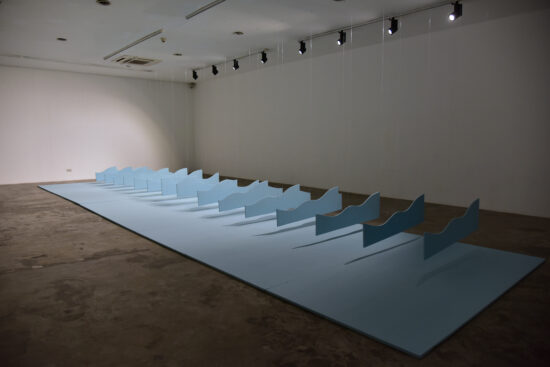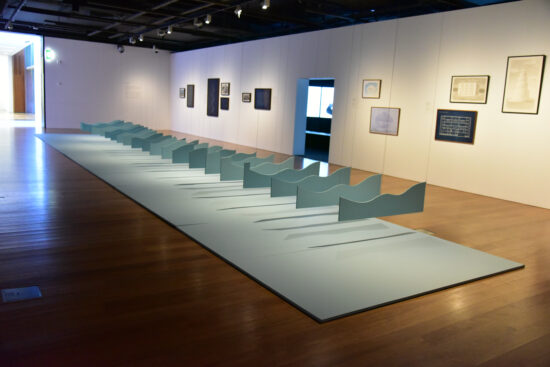Earlier this fall, contributing authors Martha Singer, Gail Vicente, and MM Yu wrote about their ongoing work with the archive of Filipino conceptual artist Roberto Chabet (1937-2013) and the many conservation challenges presented by the scale and scope of materials he employed. The following article continues their story, and outlines the results of some of their vital research. To read Part 1 of this series, click here.
Gail Vicente and MM Yu, from King Kong Art Projects Unlimited (KKAPU) in the Philippines, were tasked with archiving the installations of Roberto Chabet, an influential South-East Asian conceptual artist. With the Asian Cultural Council’s (ACC) support, they came to New York City in 2019 to learn about the various approaches and techniques used in the conservation of art installations[1].
Together with the ACC, Martha Singer, a conservator specializing in modern and contemporary art, developed a mentoring program for Vicente and Yu that included arranged visits to multiple artist archives, libraries, and museum conservation laboratories around NYC. These visits were intended to broaden their understanding of preservation, maintenance, and management of contemporary artworks, including traditional and time-based media. This project led to a new portal of knowledge for them. Vicente writes, “It was important to understand the significance of conservation; an artwork is a cultural object where elements like time, place, people and systems intersect. Conservation gives us a sense of history as derived from works of art.”
Especially valuable were visits to artist foundations. Artist archives present unique situations not experienced by museum or private conservators. Some artworks fall into a grey area because they are not formal, finished artworks, and they are not archival material either. How are these objects labeled and where do they live in the collection? The Artist-Endowed Foundation Archivists is a self-organized New York City-based group, that holds regular informal meetings to discuss topics of common interest to which Yu and Vicente were invited[2]. They are now trying to emulate this group by creating an Asian Artist Archive Resource Group to discuss significant topics with regional colleagues.
Another valuable visit was at the Solomon R. Guggenheim Museum with Francesca Esmay, Conservator of the Panza Collection[3]. Esmay, using a work by Flavin (Untitled to Henri Matisse) as an example, discussed that work could exist in three different “states”: (1) the certificate of authenticity or proposal from the artist; (2) the physical light box holding the lights; and (3) experiencing the lights with electricity. For those preserving the artworks, how do you resolve, manage, and preserve all these “states” and their meanings? Vicente and Yu concluded that there is no perfect solution for many of these questions; each archive must adjust around the artist’s working style and philosophy. Part of archiving the artist’s legacy is continuing the artist’s unique approach to what constitutes a work of art.

In addition to visits at artist foundations and meetings with archivists, Vicente and Yu felt they greatly benefited from practical exercises on Chabet’s work. Chabet used readymade or common building materials (large plywood sheets, roofing materials, flood lights, neon lights) and did not store the materials after exhibitions, but donated them to artist groups or people in need. Conservators and curators depend on an artist’s estate to decide what material would be appropriate for replacement. However, if you are the archivist, how do you make that decision? Singer worked with Vicente and Yu to help them understand through writing identity and condition reports, iteration reports, and installation instructions (see example templates from museums below). What materials existed for each installation? Did the artist leave specific instructions regarding the appropriate materials? What changes have already taken place in past exhibitions? Were those changes appropriate for the work? And, what might be some future challenges for the production of Chabet’s installations. As many of these works exist only during exhibition, conservation practice in this case is about managing change over time.[4] Four case studies of Chabet’s installations helped Vicente and Yu document the essential materials, qualities and decision making so that future generations would have sufficient clues to understand prior decisions. They also realized the need to interview the curators and friends of Chabet before they lose more memory and information.
To help readers appreciate the challenges associated with the conservation of Chabet’s installations, we conclude this blog with a case study on one of his work entitled Waves. Waves consists of a series of uniquely shaped wooden panels that move over panels on the floor, both painted pale blue. Each wave, attached to the ceiling with translucent filaments, sways when gently pushed, creating the sensation of an ocean. Waves was exhibited four times from 1972 to 2018. Variations included: fewer panels were exhibited because of a smaller exhibition space; waves were re-painted; new floor panels were purchased to avoid shipping; lighting in one location emphasized the clear filament.

Video by MM Yu.
The archivists dissected these variations in iteration reports and documented who made decisions and why. Although traditional conservators would not have re-painted the waves, the archives’ guiding principles came from the re-making of Chabet’s works for each exhibit. Re-painting emphasized the artist’s typical working process and his oeuvre. For Vicente, every iteration of the artwork allows for a new form and some change as Chabet was accepting of imperfections in his work. The installation guidelines had to distinguish between fixed components that are central to conceptual aspects of the work and those aspects that could change. Vicente concluded: “The archive cannot complete a whole story, nor can it supply absolute information; it can only provide fragments and portions about, in this case, a particular work of art.”
[1] For Vicente and Yu, coming to the United States, sponsored by the same organization (ACC) which had brought their mentor fifty years prior, was a meaningful coincidence that they could not ignore.
[2] Thank you to Janine Biunno, Archivist for The Isamu Noguchi Foundation and Garden Museum, for including Vicente and Yu in this discussion group while they were in New York.
[3] For information on the Panza Collection and its archive, see:https://www.guggenheim.org/finding-aids/collection/a0071. To see videos of “Object Lessons: the Panza Collection Initiative Symposium (April 9-10, 2019)” visit: https://www.guggenheim.org/conservation/the-panza-collection-initiative/object-lessons-the-panza-collection-initiative-symposium. Esmay discusses the Flavin example in “Orientation and Overview: Part I”.
[4] Discussion at the Getty on Contemporary Art: Competing Commitments: A Discussion about Ethical Dilemmas in the Conservation of Modern and Contemporary Art: https://www.getty.edu/conservation/publications_resources/newsletters/24_2/dialogue.html
For templates of identity reports and iteration reports from museums, see:
Guggenheim: https://www.guggenheim.org/wp-content/uploads/2015/11/guggenheim-conservation-iteration-report-2012.pdf
Hirshhorn Museum and Sculpture Garden: https://www.si.edu/tbma/resource/iteration-report-template
Metropolitan Museum of Art: https://www.metmuseum.org/-/media/files/about-the-met/conservation-and-scientific-research/time-based-media-working-group/artist-iteration-report.pdf?la=en
Museum of Modern Art: https://www.mediaconservation.io/resources#getting-started
Smithsonian American Art Museum: https://www.si.edu/content/tbma/documents/8_SAAM_TBMA_FormSet_Template_IterationReport.pdf
